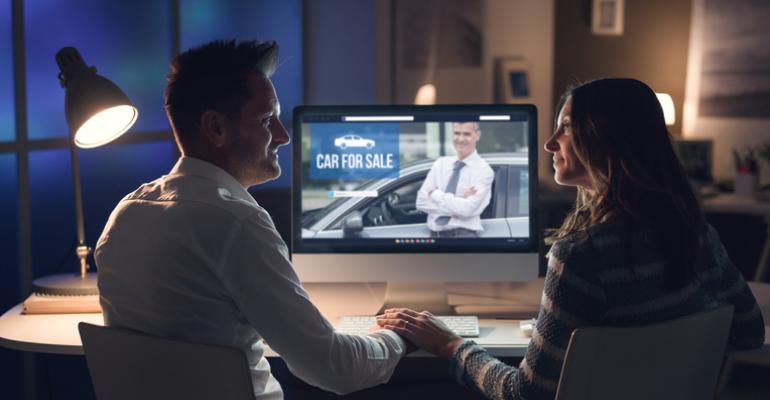Videos are gaining popularity on auto-retailing websites, which continue to offer more user functionality.
It’s largely a matter of giving online consumers digital tools they want, says Jessica Stafford, head of Autotrader and Kelley Blue Book, both Cox Automotive units.
“Video is so where shoppers are at,” she tells Wards. “Dealers are using video assets to get in front of potential buyers, particularly young people, who are such visual people.”
Videos on car-buying websites now include 360-degree vehicle “walkarounds” and clips showing dealership facilities and staffers.
Stafford (pictured, below left) advises dealers to include “rich video assets” in their digital portfolios.
 Digital auto retailing in various stages has been around for years, but it took off during the height of the COVID pandemic, a time when dealership showrooms were temporarily closed in several states because of government-ordered lockdowns.
Digital auto retailing in various stages has been around for years, but it took off during the height of the COVID pandemic, a time when dealership showrooms were temporarily closed in several states because of government-ordered lockdowns.
The COVID-related increase in digital auto retailing spurred the addition of more functionality and richer content. “So much more is digital now,” Stafford says of car buying. “Customers expect it.”
It increasingly draws younger shoppers. More than 20% of Autotrader.com’s visitors are age 18 to 34. That same age group represents about a quarter of Kelley Blue Book visitors.
The so-called journey to a car purchase has changed not only for buyers, but for sellers, too.
“The auto dealer’s journey has to change, and is changing,” Stafford says. “It is agile and adaptable and has become way more reactive to what customers want.”
Before, the main aim was to get customers in the dealership door as quickly as possible. The digital world has altered that.
“It’s probably the most dramatic change,” Stafford says “You no longer wait for the customer to walk in. You can have online conversations with them beforehand. Customers are saying, ‘Tell me about the car before I go in.’”
She adds: “If you don’t give customers the information up front, if you don’t answer their online questions through chat, text, email or whatever channel, they won’t come in. If you don’t show your cards, they will go away.”
When customers interact with a dealership staffer, whether online or in person, “they don’t necessarily want a ‘salesperson,’” Stafford says, citing Cox Automotive surveys. “They want a product specialist. So, dealers have adjusted to that.”
The way consumers currently shop for vehicles has rapidly changed because of an industrywide inventory shortage. That’s caused by a global microchip shortage that has forced automakers to cut production.
In response to the inventory shortage, Autotrader has launched a new product, New Car Custom Order.
It garners new-car leads from shoppers interested in pre-ordering vehicles that aren’t yet built.
“It sets expectations,” Stafford says. “It’s an answer to what is happening in the industry today.”
Will that ordering option abate when inventory levels return to normal levels, whenever that might be?
“When that happens, pre-ordering will probably go down,” Stafford says. But as with many digital tools, “once customers have something, they want to keep it.”
Autotrader and Kelley Blue Book differ but both serve as third-party sales lead providers for dealer clients.
Kelley focuses more on pricing and residual values while Autotrader centers on dealership inventory listings.
“They are different websites with different platforms, but there’s a synergy,” Stafford says. “Consumers go to them for different reasons. The goal for both is to send ready-to-buy customers to dealers.”
Steve Finlay is a retired Wards senior editor. He can be reached at [email protected].





